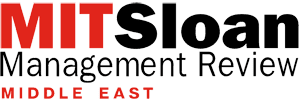Who’s Making Your Talent Decisions?
Talent management software promises efficiency and objectivity, but in practice it can limit company-specific talent strategies.
News
- UAE introduces federal law to regulate child safety across digital platforms
- Middle East Has a Competitive Advantage as a Data Center Powerhouse, Says BCG
- CBD Becomes the UAE’s First Bank to Go Live Under the Open Finance Framework
- Will Halt Potential Rogue AI Systems, Says Microsoft AI Chief
- Google Bets Big on Data Infra With a $4.75B Deal in Intersect
- OpenAI Softens ChatGPT’s Tone While Scaling for an AI Showdown

Oivind Hovland/Ikon Images
“Do we have the right people in place to execute our strategic plans?” That perennial question for organizational leaders has spurred the adoption of practices and systems designed to identify and develop valuable individuals within workforces. But amid the proliferation of digital solutions to this problem, a new question has emerged: Who’s making decisions about your people — your most promising employees and future leaders? For many large companies, the answer may not be internal stakeholders who are keenly attuned to the organization’s strategic needs but rather an industry-standard one-size-fits-all piece of commercial software.
Cloud-based software services have wrought a profound transformation in the HR technology landscape, reshaping how larger organizations approach talent management. Gone are the days when internal executives were responsible for working with IT on bespoke systems, crafting and overseeing talent frameworks, and managing talent data, given that vendors now offer those services for a subscription fee.
HR leaders’ inclination to rent predesigned talent solutions appears to be unwavering, despite concerns about the value derived from such technology: In a 2024 Gartner survey, only 35% of HR leaders said they are confident that their current approach to technology is helping to achieve business objectives. Nonetheless, in a different survey, Gartner found that technology was the top spending priority for HR leaders in 2024.1
Much of the enthusiasm for HR technologies is driven by the desire to achieve cost efficiencies associated with routine administrative tasks. Vendor-designed software may also promise to help organizations transition to and enact evidence-based decision-making. Cloud-based software suites capture data, manage information, and generate the reports upon which many decisions — including promotions, rewards, and resource allocations — are based. Dashboards allow executives to compare employees and, with just a click or two, identify the best and worst performers across various criteria. These criteria, however, are preselected. Vendors tout their products’ so-called best practices and imply that the criteria and processes for talent identification are based on scientific principles and support business goals. The reality, however, is more nuanced.
Fit for Sale or Fit for Purpose?
The interests of vendors and their customers are rarely perfectly aligned, but the misalignments in digital talent management (DTM) systems are particularly concerning. Vendor offerings are more fit for sale than fit for purpose: They encode frameworks that are palatable, mirror conventions (even those that are not science-based and/or validated), are designed not to provoke any cognitive dissonance, and have been turned into commodities. But a one-size-fits-all approach that uses standard criteria for talent identification, even if customizable, is limited when it comes to supporting unique organizational talent plans that are aligned with a particular business strategy.
Vendors’ systematic talent management approaches, underpinned by predefined criteria, establish the who (the individuals designated as valuable because of their high potential and/or high performance) and the what (the specific skills and capabilities, roles, and positions deemed valuable). DTM systems shape talent definitions and evaluation criteria. Thus, as my colleague Janet Marler and I argued in a research paper we cowrote, the increasing digitization of this field empowers technology vendors to define talent on behalf of their customers.2 Then, automated processes draw on HR system data about competencies, personal attributes, technical and professional knowledge, and experience, to attach scores and labels to individual employees.
While vendors’ sales strategies typically focus on the touted benefits of standardized evaluative criteria and processes, organizations seeking talent management solutions are striving to realize strategic outcomes. Talent management and data-driven decision-making must take an organization’s unique context and strategic imperatives into consideration; defining and deploying talent within this context is inherently nuanced and context-specific. Each organization’s definition of talent must align with its objectives and its specific workforce needs and preferences. Talent management frameworks that are fit for purpose should support flexibility in talent definitions and approaches, as each organization has (or needs) a distinct talent ideal.
However, this need for diversity and context-specific talent attributes is misaligned with vendors’ promotion of standardization and generic talent frameworks. The implications of choosing licensed software encourages organizations to agree, either explicitly or implicitly, to adapt their talent management practices to conform with those designed by the vendor. Customization, while possible, incurs additional costs that can quickly negate any desired cost efficiencies of using a more automated approach. Focusing on costs encourages decision makers to satisfice — that is, to accept a solution that is satisfactory rather than ideal. In this case, it means adopting proxies or criteria and processes that appear to be reasonable or at least close enough to what is sought instead of searching further for solutions that would better support the alignment between the system and strategy.
The alternative, a business-driven approach, values organizational knowledge and prioritizes designing fit-for-purpose software systems. A business-driven approach allows the organization to leverage its internal talent, maintain control, validate talent criteria, deploy context-specific updates, respond to changing externalities, and/or capitalize on emerging opportunities. These forward-looking capabilities, in particular, are limited by off-the-shelf software that has a static view of talent based on backward-looking criteria. Executives gain strategic insight by considering and articulating how future talent ideals will likely need to differ from current ones and identifying the key areas where the return on improved performance matters.
By designing and adopting talent systems in-house, decision makers can define and prioritize multiple talent ideals that serve different strategic needs rather than trying to identify a single, all-encompassing talent ideal. Adopting multiple talent ideals enables dexterity, fluidity, and a broader perspective of the talent puzzle.
The Limitations of a Systematic Approach
On the face of it, standardized, systematic talent management systems with a structured set of processes are appealing to many decision makers, especially in HR, where consistency, accurate or not, may seem to signal fairness. Further, these systems enable organizations to implement new control mechanisms, and some leaders want to control the process of talent identification in scalable ways.
The emphasis on a systematic approach enacted via algorithms typically centers on quantitative measures and scoring systems, which are embedded in technologically enabled talent processes. It’s vital to acknowledge at the outset that not every aspect of talent can be quantified or measured. But when measurements are applied, they are often distilled into arbitrary scales, such as the common 1-5 or 1-7 rating systems. Because assigning someone a numeric rating is an inherently subjective process, it’s problematic to compare the ratings of employees who have been evaluated by different managers. Use of numerical rating scales has also been found to be problematic because evaluators’ ratings may be influenced by their desire to protect their own image or avoid conflict, and by their own biases. Rating scales have also been shown to be destructive to employee engagement.3
Some decision makers use the touted objectivity of vendor-designed frameworks to avoid providing meaningful explanations to employees who question their decisions. Managers may treat talent scores and the outputs of ranking algorithms as objective reflections of an individual’s value and rely on them to justify an employee’s inclusion or exclusion from talent development opportunities.
Nonetheless, numbers-driven talent frameworks are widely accepted as the definitive means of defining talent. This is despite evidence that decision makers commonly accept evaluative scores without rigorously questioning their accuracy, their validity, or the assumptions about the meaning of talent or success that underlie the criteria. Decision makers may assume that standardized scoring provides sufficiently accurate data about individual value, serving as a proxy for determining whether a person qualifies as talent. Although there is growing evidence of the ways in which algorithms encode humans’ biased assumptions, the tools are seen to rest on the foundation of the best scientific principles and to embody fairness, ensuring that all individuals have access to the same framework (reflecting procedural justice). The real test of fairness, however, is in outcomes: Who, ultimately, is deemed worthy of growth opportunities on the basis of algorithms that cannot accommodate nuance and context? We can also embrace mathematician Cathy O’Neil’s pertinent question, “Who does this algorithm fail?”4
Relying on commercial talent systems limits organizational learning and professional development because the reasoning behind algorithmic judgments rendered by vendors’ systems is opaque. Individuals subject to sorting by talent management systems have little recourse when excluded from opportunities, because there is no meaningful explanation of why decisions are made or what information could be provided to amend or reverse an individual’s ranking, categorization, and labeling. Instead of fostering healthy dialogue between managers and their subordinates about what constitutes talent in a specific context, algorithmic judgments and talent determinations are one-way communications.
Who’s Defining Talent?
A reliance on commercial talent systems significantly shapes how managers perceive talent, directing their focus toward specific elements while obscuring others. Vendors establish criteria, defining the “what” of talent, which fundamentally influences the attributes managers seek and the parameters by which individuals are judged. Vendors shape what becomes visible and what remains hidden and guide the attention and focus of direct line managers during the evaluation process. They prescribe the lenses through which assessments are conducted, dictating what managers should observe and evaluate.
Vendors’ talent systems play a pivotal role in directing people’s attention toward attributes, criteria, and evaluation parameters that they might not have prioritized. These factors then define the boundaries around talent conversations, what is deemed relevant, and what remains on the periphery. One significant disconnect with standardized criteria is that most decision makers care more about talent in action: They are interested in how individuals perform their talent within the context of expectations and in comparison with their peers, how employees set goals, and how talent is salient to strategic execution in a particular context.
HR leaders’ acceptance of vendors’ definitions, criteria, and evaluation processes can be seen as an abdication of their responsibility to develop talent strategies fit for the organization. If talent is to confer competitive advantage, it’s essential for key decision makers to come together and discuss how talent should be defined so that it’s relevant to the organization, and what criteria, evaluation, and decision processes are most appropriate in context. While it may seem convenient to delegate to vendors the foundations and parameters of talent discussions, doing so can risk missing the subtleties and nuances that make up a holistic understanding of talent for a specific organization or the organizationwide talent puzzle.
A Tale of Two DTM Implementations
In our research for the paper I mentioned earlier, Janet and I found that even within the same corporation, managers may engage with commercial talent systems in very different ways. We studied a professional services firm (we’ll call it PSF) that strongly prioritized talent management — unsurprisingly, given that individual employees’ skills and capabilities are essentially the company’s product and are key to its competitive positioning. While the company had no overarching definition of talent, in practice talent management was chiefly about identifying individuals with the potential to become partners. A key criterion for assessing talent was the amount of revenue the individual generated.
Talent identification at PSF was the responsibility of business unit managers, supported by dedicated HR staff members. While talent was understood to mean high performers with high potential, the CEO frequently communicated that more detailed or structured definitions of talent were not necessary, through remarks such as “You know talent when you see it.”
Corporate HR had no role in talent evaluation or identification but advocated strongly for the use of a DTM system to ensure a systematic, robust, and consistent approach based on metrics and data. The HR team saw the system as a mechanism that could impose a single prescribed framework across the organization so that “everyone was working together,” as one corporate HR manager put it. However, the CEO resisted a one-size-fits-all or mandated approach, leaving business units to adopt DTM as they saw fit. And that’s where things got interesting: We observed that one business unit prioritized automation and delegated talent decisions to the system, while managers in a different business unit questioned the usefulness of the embedded algorithms and sidelined the digital talent system in favor of a collegial, human-driven process.
PSF provided finance and accounting services to external clients. As was the case in the company as a whole, stakeholders in this unit framed talent management as essential to realizing the unit’s ambitions but lacked a shared understanding of what skills or capabilities signaled talent. Line managers were willing to use the vendor-designed DTM system framework to identify talent, but after its implementation, HR managers grew concerned about its perceived limitations. They questioned both the wisdom of identifying talent on the basis of a single supervisor’s evaluation at one point in time, and the legitimacy of relying on a numerical score produced by a third party’s algorithm. So they proactively claimed their place in talent decisions to avoid being shut out by the DTM system, organizing twice-yearly forums where HR and business unit managers discussed individuals who might be singled out for development and why. These discussions transcended the DTM criteria and surfaced more nuanced factors in the who, what, and why of talent. Line managers commented positively on HR’s role, and the finance unit maintained a robust role for humans in the talent identification process.
In a different business unit, focused on delivering management consulting services, talent management was highly prioritized because the unit offered services focused on human capital. Managers in the unit considered its talent management practices to be more advanced, and more structured, than elsewhere in the company; they also had a common understanding that talent largely consisted of financial performance, business development, and leadership skills. Unlike in the finance unit, HR managers in the consulting unit highly valued the DTM technology for imposing a systematic and consistent approach. Line managers rated individuals based on predefined criteria in the DTM system, which then generated talent scores based on these subjective assessments. In this unit, it was the technology itself that controlled how managers evaluated employees, and which ones were singled out for development. The process created a situation where talent decisions were potentially based on only two opinions: the vendor’s, via its criteria and ranking processes, and a single supervisor’s subjective judgment of an individual’s performance against those criteria.
Managers in the consulting unit also turned to the DTM technology to provide a rationale for talent decisions, in the absence of the kind of talent discussions HR and line managers held in the finance unit. When asked to justify an individual’s exclusion from the talent list, HR managers could point to scores, rankings, and other results generated by the DTM algorithms. In this way, the unit’s HR team took on a more administrative role compared with their peers in the finance unit, who participated in talent decisions.
Toward Thoughtful Adoption of DTM Systems
PSF’s story is a useful reminder that leaders have choices about how to adopt digital systems that, by encoding vendor-designed frameworks in software, apply a third party’s generic definitions and processes to nuanced, highly context-dependent decisions. Keep the following in mind in order to maintain human control over the talent management process.
Dig into the details of the DTM system. Having an intimate understanding of the system’s criteria for codification and ranking processes is critical to ensuring that applying algorithms in talent management serves the best interests of individuals and the organization alike. To the extent possible, understand the rationales behind algorithmic decisions. Understanding the intricate details of the criteria and embedded algorithms at the micro and execution levels is paramount. Talent frameworks are not mere commodities; they shape careers and lives.
Intimacy with the details is particularly pertinent when we remember that vendors profit handsomely from providing companies with access to the software, irrespective of whether the software delivers value or fulfills the sales team’s promises. This kind of due diligence can help minimize an organization’s chances of implementing HR and talent systems that don’t deliver on their espoused value.5
Recognize that talent is dynamic. Both organizations and talent definitions are dynamic, and executives must recognize that the defining attributes of talent evolve. Perspectives on what constitutes talent change, and criteria for identifying individuals as talented or deserving of differential rewards must adapt to the business’s strategic requirements and external factors. Even if companies adhere to existing frameworks, shifts in the meaning of talent are inevitable.
While executives intuitively grasp the dynamic nature of talent, acknowledging the need to map talent for strategic and operational needs, they may hesitate to update vendor-designed frameworks. However, reconsidering and updating digital HR and talent systems is key to the success of development programs, succession plans, and retention efforts, and to ensuring that the criteria and weightings align with current and/or future strategic needs.
The significance of effectively updating algorithms is poised to intensify with the rising prominence of machine learning. As we shift toward machine learning algorithms that make decisions, gather data, and base their decisions on revised data, the capacity to iterate and update algorithms becomes even more crucial. Internal stakeholders must be involved in designing and deploying the updates. Exercise caution when accepting vendor updates. Your talent frameworks and decisions are directly connected to strategic success and warrant investing time, energy, and attention in deploying only strategically valuable updates.
Reflect on the risk of rewarding undesired behaviors and outputs. Narratives about unhealthy organizational cultures and workplaces marked by ethical concerns often feature prominently in the news. What are the unforeseen consequences that might arise from the implementation of specific digital talent systems? For example, some might prioritize revenue generation over collaborative behaviors when identifying high performers and/or future leaders. What unintended outcomes could result from the application of an ingrained talent framework? Consider how particular talent capability frameworks may favor certain personality traits, work styles, or other characteristics, whether directly or indirectly.
Managers should also intentionally reflect on the broader implications of the criteria for behaviors and actions. Decision makers understand that what gets measured gets managed and what gets rewarded gets repeated. The ripple effect of seemingly inconsequential talent criteria can compound negative behaviors and outcomes.
Advocate for a kaleidoscope of talent colors. Relying on binary determinations of who is talented and who isn’t, based on evaluations against a limited, predefined set of criteria, impedes our capacity to appreciate the nuanced dimensions of talent in different contexts. For organizations whose competitive standing hinges on the caliber of their talent, relying on decision frameworks embedded in vendor-designed systems can limit the diversity of talent attributes considered and sought. Ask “Who does this framework not work for?” and “Who is minimized by predefined talent criteria and rigid processes?”
Reflect on FOMO and imitation versus strategic advantage. Fear of missing out drives many technology purchases: Organizations are inclined to align with prevailing trends, lest they find themselves lagging behind. But this reaction may be a vulnerability that prompts an imitation strategy. The way that many organizations are deploying these systems now indicates a follow-the-leader rather than a be-the-leader situation. The risk is that companies are unable to realize measurable strategic gains from HR and talent technologies because they have elected, perhaps unthinkingly, to adopt talent practices that mirror those of the broader market. In such cases, companies are deploying and using criteria and processes that are essentially indistinguishable from, and imitative of, those used by their allies, suppliers, and competitors.
In contrast, those scrutinizing standardized talent systems and retaining the prerogative to architect their own unique and strategically aligned system alongside commercial vendor-designed software may seize a competitive advantage. It is not a case of rent or build but, rather, rent and build.
Pay attention to risks. Vendors’ growing influence over talent decisions raises broader societal risks that warrant careful consideration. With increasing vendor agency, we run the risk of entrusting a handful of key individuals within a limited number of companies with the authority to dictate the who, what, and how of talent management. This influence extends not only within individual organizations but also across geographical boundaries.
The implications of such centralized control are far-reaching, given that it can lead to a standardization of talent frameworks that may not adequately address the diverse needs and nuances of different regions and industries. Moreover, the concentration of power in a select few can stifle innovation and limit the opportunity for new perspectives and approaches to emerge in talent management.
When leaders elect to adopt commercial software systems in decision-making, they should retain the power to tune those systems so that they are fit for purpose. Ideally, these digital decision-making frameworks should be flexible to accommodate the processes and criteria that managers deem most relevant at the time. Managers must be thoughtful about where they choose to rely on technology-enabled, standardized decision-making processes and when to dial down their influence in favor of nuanced, considered human judgment. They should ensure that technology and technology vendors do not dominate as the sole voice in decision-making processes. Fostering a deliberate, intentional, and informed approach that draws on both internal human voices and technological capabilities ensures that talent decisions are strategically aligned and can deliver business impact.
References
1. “Gartner Survey Reveals Only 24% of HR Functions Are Maximizing the Business Value From HR Technology,” Gartner, June 13, 2024, www.gartner.com; and “Gartner Identifies Top Four HR Investment Trends for 2024,” Gartner, May 16, 2024, www.gartner.com.
2. S. Wiblen and J.H. Marler, “Digitalised Talent Management and Automated Talent Decisions: The Implications for HR Professionals,” The International Journal of Human Resource Management 32, no. 12 (July 2021): 2592-2621.
3. L.A. Rivera and A. Tilcsik, “Scaling Down Inequality: Rating Scales, Gender Bias, and the Architecture of Evaluation,” American Sociological Review 84, no. 2 (April 2019): 248-274; and D. Rock, J. Davis, and B. Jones, “Kill Your Performance Ratings,” Strategy+Business 76 (autumn 2014): 1-4.
4. H. Bowne-Anderson, “Cathy O’Neil Discusses the Current Lack of Fairness in Artificial Intelligence and Much More,” R-bloggers, Nov. 26, 2018, www.r-bloggers.com.
5. D. Grant, K. Dery, R. Hall, et al., “Human Resource Information Systems (HRIS): An Unrealised Potential” (paper presented at the CIPD Annual Conference and Exhibition, Manchester, England, Nov. 17-19, 2009); and K. Dery, R. Hall, N. Wailes, et al., “Lost in Translation? An Actor-Network Approach to HRIS Implementation,” Journal of Strategic Information Systems 22, no. 3 (September 2013): 225-237.








